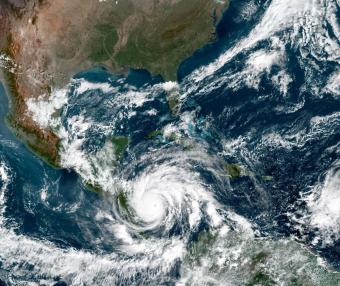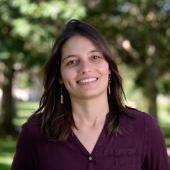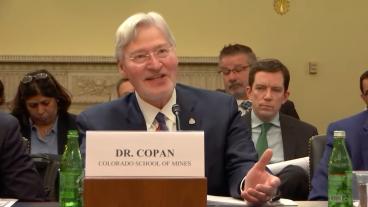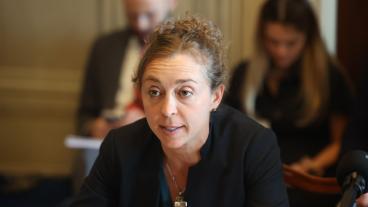Mines researcher flying into eye of storm to learn more about air-sea interactions

A team of Colorado School of Mines researchers will get to fly into the eye of the storm during hurricane season in hopes of learning more about the way the ocean and atmosphere interact during extreme weather.

Bia Villas Bôas, assistant professor of geophysics at Mines, is a physical oceanographer combining observations, theory and modeling to further our understanding of how coupled air-sea interactions affect the environment.
She and her research group are part of a new $9 million Office of Naval Research project with the University of Notre Dame, Woods Hole Oceanographic Institution, University of Washington, and Colorado State University.
Together, the researchers aim to enhance the predictive capabilities of extreme weather events by understanding the physics that govern and describe how ocean waves affect the atmosphere and upper ocean properties. While there is previous research on these interactions, there is a lack of knowledge surrounding air-sea coupling during high-wind storms and extreme weather conditions.
“A big motivation behind this project is that the frequency and intensity of these extreme weather events is changing as a result of climate change,” Villas Bôas said. It is more important than ever to create reliable weather predictions in the face of future natural disasters and extreme weather events, she said.
Over the next five years, Villa Bôas and her team of postdoctoral researchers and graduate students will participate in three field campaigns. These field campaigns will take place during hurricane season, in which airplanes provided by the U.S. Air Force and the National Oceanic and Atmospheric Administration, will measure the onset and propagation of extreme weather features, such as tropical cyclones, using advanced oceanographic and atmospheric instruments.
Villas Bôas has spent the last 10 years researching ocean surface waves. Now, she and her team will focus on modeling those waves for this project.
The ocean acts as a major reservoir for heat and carbon, which in turn, affects the atmosphere, she said. Ocean surface waves, which are the waves you see from a boat or on the beach, are responsible for mediating heat, momentum and gas exchanges between the ocean and the atmosphere.
“Waves are the interface separating the ocean from the atmosphere.” Villas Bôas said. “Only now do we have the technology and resources to observe these three processes – ocean, atmosphere, and waves – in an integrated way.”
And while she and her team are studying ocean processes, Villas Bôas said they affect much more than just the ocean climate. For example, these processes could help predict the climate in Colorado and whether we receive a large snowfall or a dry heat wave.
Villas Bôas plans to incorporate the data collected from the project into her classes, so her students can study and observe a concrete example of how to better prepare society for these changes. She also hopes that this project will come with a lot of future fieldwork opportunities for her team, putting Mines on the map for oceanography.
“This is a huge milestone in my career,” Villas Bôas said, “The project spans several disciplines and I’m excited to learn from others and get to teach what I’m so passionate about.”



